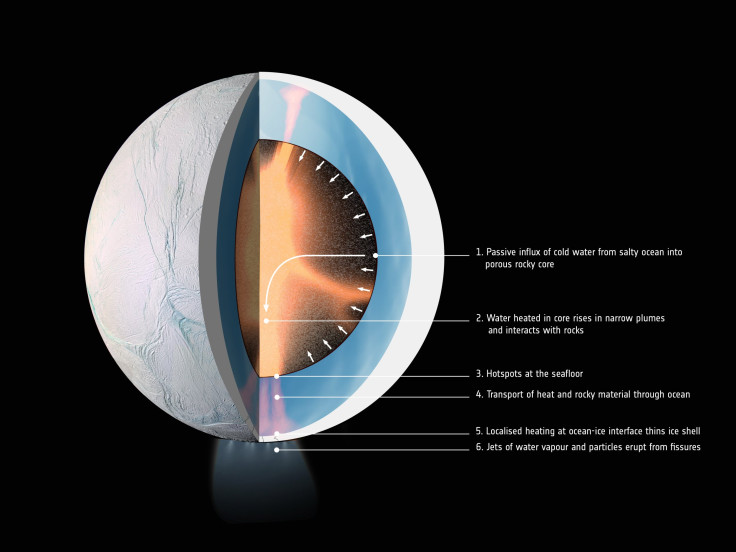Saturn’s Ocean Moon Enceladus May Have Porous Core, Creating Tidal Friction Energy

Soon after the Cassini spacecraft began studying the Saturn system from up-close, it found one of the planet’s larger moons — Enceladus — spraying long jets that were plumes of water vapor and icy particles. These streaming jets originated near the moon’s south pole, and are evidence of hydrothermal activity below the moon’s icy exterior.
Based on Cassini’s observations, scientists found that while the surface of Enceladus — Saturn’s sixth-largest moon — was icy, there was a global sub-surface ocean that had energetic reactions going on, leading to the plumes of volatiles from near the distinctive southern feature known as the moon’s “tiger stripes.” But the source of that energy which is powering those reactions has remained unidentified.
A paper published online Monday analyzes more data from Cassini to put forward a new theory to answer the question that has puzzled scientists for over a decade now. It proposes that Enceladus has a highly porous core, allowing water from the ocean to easily permeate it, where tidal friction causes it to heat up. Being hotter than its surroundings, it rises back up to the base of the ocean, and reacting with the rocks on the ocean floor, shoots up in plumes.
“Where Enceladus gets the sustained power to remain active has always been a bit of mystery, but we've now considered in greater detail how the structure and composition of the moon’s rocky core could play a key role in generating the necessary energy,” the paper’s lead author Gaël Choblet from the University of Nantes in France, said in a statement Monday on the European Space Agency’s (ESA) website.
On looking at properties of the ejecta from Enceladus, the researchers concluded it suggested hot water — at least 90 degrees Celsius (194 degrees Fahrenheit) — had a role to play in its formation. That amount of heat needed to heat water to that temperature could not be explained by the decay of radioactive elements in the moon’s interior, which would produce one about one-hundredth of the energy required.
Enceladus has an elliptical orbit around Saturn, and the planet’s tidal effect is thought to deform the moon’s icy shell, which has an average thickness of about 20-25 kilometers (12-15 miles) but is only 1-5 kilometers thick near the south pole. By itself, energy generated by the tidal friction would not be enough to make up for the loss of heat through the ocean, and the whole body would completely freeze over in about 30 million years.
But since Enceladus is still visibly active, scientists had to come up with another explanation.

Simulations by the researchers took “a loose, rocky core with 20 to 30 percent empty space.” Rocks in this flexible core rub together to generate heat and the model also accounts for the plumes emerging from the south pole, where the ice is thinner than elsewhere on the moon, at least partially because of the warm water beneath.
“The study is the first to explain several key characteristics of Enceladus observed by Cassini: the global ocean, internal heating, thinner ice at the south pole, and hydrothermal activity. It doesn't explain why the north and south poles are so different though. Unlike the tortured, geologically fresh landscape of the south, Enceladus' northern extremes are heavily cratered and ancient,” NASA said in a statement Monday.
NASA’s Cassini Project Scientist Linda Spilker at the Jet Propulsion Laboratory in Pasadena, California, said in the statement: “This powerful research makes use of newer details — namely that the ocean is global and has hydrothermal activity — that we just didn’t have until the past couple of years. It’s an insight that the mission needed time to build, one discovery upon another.”
Titled “Powering prolonged hydrothermal activity inside Enceladus,” the paper appeared in the journal Nature Astronomy.
Cassini was launched in 1997 and reached the Saturn system in 2004. Its flyby of Enceladus in 2005 led to the first observation of the plumes from the moon’s south pole. The spacecraft ended its mission and its life on Sept. 15, 2017, when it plunged into the gas giant’s atmosphere.
© Copyright IBTimes 2024. All rights reserved.





















